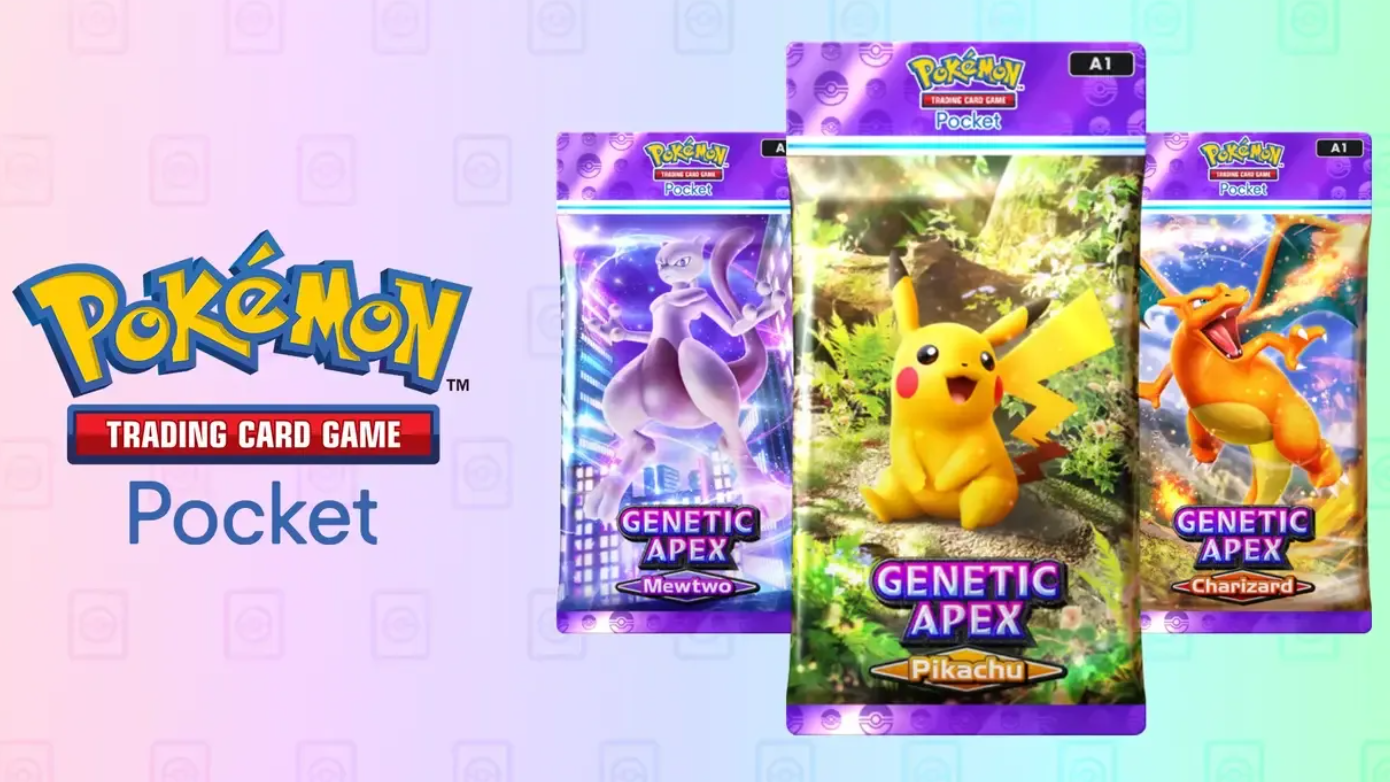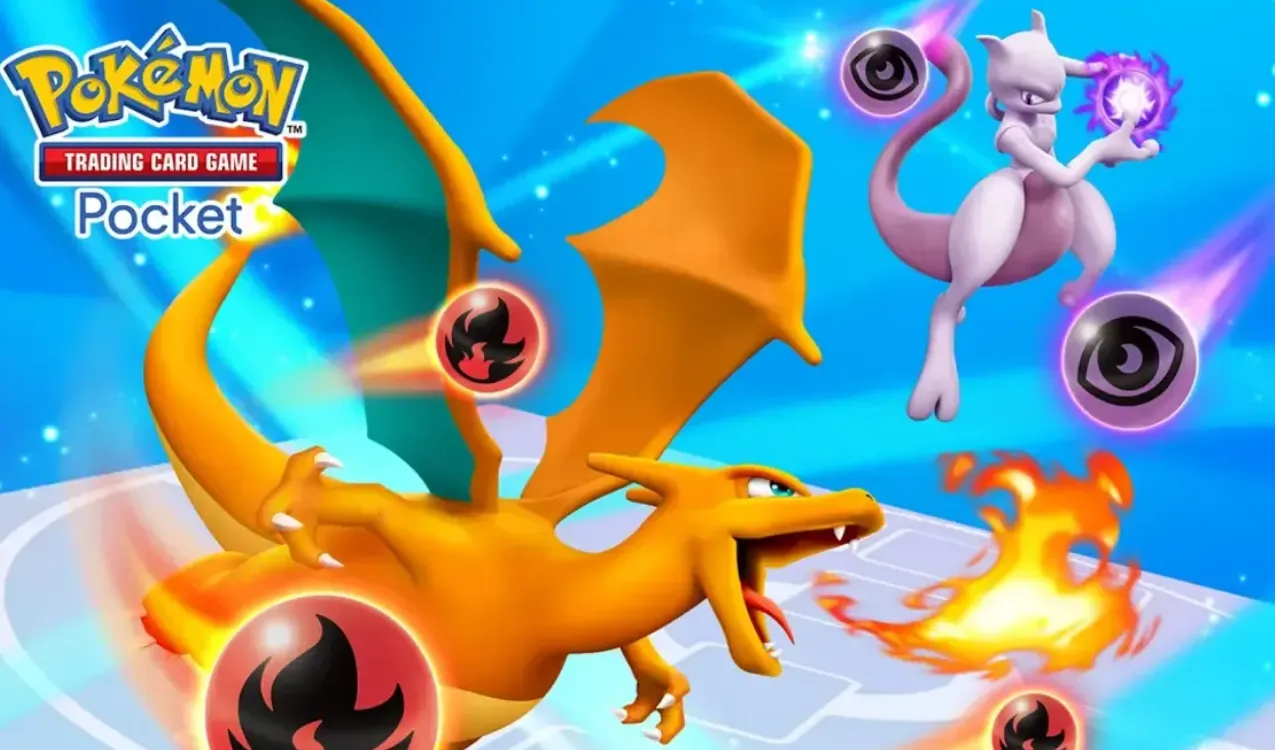Flair in Pokémon TCG Pocket is a cosmetic system that lets you turn duplicate cards and Shinedust into animated effects on your collection and in battles. It never changes card power or game balance, but it does give high-duplication commons and big-ticket rares a second life.
What flair is in Pokémon TCG Pocket
Every Pokémon card can unlock up to four flair effects. These fall into two broad types:
| Flair type | Where it appears | Typical use |
|---|---|---|
| Cosmetic flair | On the card art itself in binders, display boards, and when the card appears in battle | Sparkles, glitter, extra visual motifs that sit “on top” of the card |
| Battle flair | Only when the card is played or swapped in/out during a match | Bursts, shapes, elemental effects that fire when the Pokémon hits the field or attacks |
The exact flair options depend on both rarity and theme. A low-rarity diamond Pokémon might get simple stars or sparkles, while a 1-star full-art Mewtwo ex leans into purple bursts and angular shapes. Flair is card-specific: a Bulbasaur flair only works on that Bulbasaur’s card ID, not on a different Pokémon.
Flair is permanent once crafted. You can remove or swap it on and off cards, but you cannot “refund” the Shinedust or the duplicates you spent to unlock it.
How Shinedust and duplicates work with flair
Unlocking flair always consumes two things:
- Shinedust – a currency earned from pulling duplicate cards, leveling up, achievements, and event rewards.
- Extra copies of the card – you must have more than the two copies you’re allowed to run in a deck.
You never sacrifice your last playable pair of a card: the game will not let you buy flair if you would drop below two copies of that card. For diamond-rarity cards, that means your “usable” duplicates only start at copy number three; for higher rarities that require fewer dupes per flair, the principle is the same.
Tip: Missions that track things like “collect N copies of a certain Pokémon or type” count everything you have ever pulled, not just current ownership, so spending extras on flair does not undo that mission progress.
Flair costs by rarity
Each card has four flair “tiers.” You pay the same number of duplicate cards for every tier on that card, but the Shinedust cost scales up for each successive flair.
For diamond (◇) cards, you must unlock the earlier flair tiers in order before the later ones appear. For star (☆) and crown cards, all four flair recipes are visible from the start, and you can jump straight to an expensive option if you have enough Shinedust and at least one dupe.
| Rarity | Duplicates required (per flair) |
Shinedust per flair (1st / 2nd / 3rd / 4th) |
|---|---|---|
| 1-diamond (1◇) | 3 extra copies | 50 / 75 / 150 / 225 |
| 2-diamond (2◇) | 2 extra copies | 80 / 120 / 240 / 360 |
| 3-diamond (3◇) | 1 extra copy | 360 / 540 / 1,080 / 1,620 |
| 4-diamond (4◇) | 1 extra copy | 720 / 1,080 / 2,160 / 3,420 |
| 1-star (1☆) | 1 extra copy | 500 / 750 / 1,500 / 2,250 |
| 2-star (2☆, Pokémon only) | 1 extra copy | 1,800 / 2,700 / 5,400 / 8,100 |
| 3-star (3☆) | 1 extra copy | 4,000 / 6,000 / 12,000 / 18,000 |
| Crown (♛) | 1 extra copy | 20,000 / 30,000 / 60,000 / 90,000 |
| Promo Trainer | 1 extra copy | 50 / 75 / 150 / 225 |
| Promo Pokémon | 1 extra copy | 500 / 750 / 1,500 / 2,250 |
Note: These duplicate counts are “on top of” the two copies you keep to play. If a 2-diamond card needs two duplicates for a flair, you effectively need four total – two you keep, two you trade in.
Exceptions and special cases
Most cards follow the table above, but there are a few important edge cases:
- Premium shop Pikachu (promo) – does not require a duplicate at all. You only pay Shinedust for its flair tiers.
- 2-star Trainer cards – do not offer flair options at the moment. Extra copies of these can instead be converted into Special Shop Tickets rather than cosmetics.
- One-of Pokémon (like Mew or some Premium rewards) – can unlock flair with Shinedust alone, without needing extra copies, since the game only ever gives you a single copy.
Some promo cards internally “mimic” the flair rules of their non-promo version (for example, a promo based on a 1-diamond design follows that flair structure) but always use just one duplicate instead of three or two, unless they are in the one-of category.
How to unlock flair on a card
The unlock flow always starts from your collection.
- Open the app and go to My Cards.
- Use the sort options to surface duplicates easily (sorting by “Duplicates” stacks your most repeated cards at the top).
- Tap a card with enough copies and Shinedust available.
- Tap Obtain Flair.
The game then shows a flair screen for that card with the following:
- The list of flair tiers for that card, showing type (cosmetic or battle) and visual thumbnail.
- The Shinedust cost and required duplicates for the currently selected flair.
- How many copies of the card you will have left after the exchange.
Confirm by tapping the exchange button. The duplicate cards are removed from your collection, Shinedust is spent, and after a short animation, the flair is added to your account and is permanently available for that card ID.
For 1–4 diamond cards, only the first cosmetic flair (commonly “Sparkles Flair: Gold” or a similar basic effect) is visible initially. Buying that first tier reveals the next three tiers in order. For 1-star and above, all four options are visible and purchasable in any order from the moment you open the flair screen, as long as you have at least one extra copy of the card.
You can buy the same flair multiple times. Each purchase creates a separate copy that can be equipped to another copy of that card. That matters if you want both copies of a Pokémon in a deck to share the same animation.
Where you can use flair
Once unlocked, flair can be shown in three main places:
| Context | What flair shows | How players see it |
|---|---|---|
| Decks (battles) | Cosmetic + Battle flair | On your hand and field art, and when a flaired card enters or attacks |
| Binders | Cosmetic flair only | On cards displayed in a binder layout |
| Display Boards | Cosmetic flair only | On cards pinned to your display board |
Flair is tied to individual card copies in those contexts. One cosmetic flair cannot animate every copy of that card across all decks and binders at once; you choose where that specific flair instance is equipped.
How to equip flair in decks, binders, and display boards
Unlocking flair does not automatically apply it. Equipping is a separate step.
Equip flair on a deck card
- Open the Deck menu and select the deck you want to edit.
- Tap Edit so the deck list becomes interactive.
- Look for a small flair icon on cards that have at least one unlocked flair.
- Tap the flair icon to open the flair selection for that card slot.
- Select the cosmetic and/or battle flair you want, then confirm with Use (or equivalent).
- Save the deck changes.
From then on, whenever that exact copy of the card is used in matches from that deck, its chosen flair will appear. If you want the same flair on the second copy of that Pokémon in the same deck, you must either:
- Equip the same flair if it is free (not already attached elsewhere), or
- Buy a second copy of that flair for the card, then equip it to the second slot.
Equip flair in binders and on display boards
- Open My Cards, then go to your Binder or Display Board setup.
- Tap Edit to modify which cards are pinned.
- Tap a card that supports cosmetic flair; a flair icon appears if any are unlocked.
- Tap the flair icon, choose the cosmetic flair you want, and apply it.
- Save the binder or board.
Only cosmetic flair appears in these display contexts; battle-only flare effects do not trigger when simply viewing a binder or board.

Choosing where to spend Shinedust
Because flair requires both currency and duplicates, it sits in the same economy as several other systems:
- More Shinedust comes from opening duplicates – so high-volume pack openers will naturally unlock more flair.
- High-rarity flair is dramatically more expensive in Shinedust than common flair, but needs far fewer extra copies.
- Star and crown cards can also feed into Special Shop Tickets instead of cosmetics, competing with flair for the same duplicates and Shinedust.
A practical approach is to use early Shinedust on cheap commons and 1-diamond cards to learn how flair behaves, then hold larger balances for specific star or crown cards you actually play. Since flair offers no gameplay advantage, it is safe to ignore it entirely until you are satisfied with your decks and ticket plans.
Once you understand these costs and flows, flair becomes a flexible outlet for card duplication instead of a random side feature: you decide whether a stack of Kirlias turns into sparkles, or whether that extra Mewtwo ex becomes an on-board flex piece instead of a forgotten dupe.


